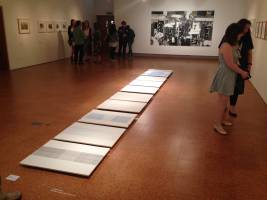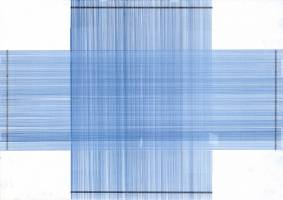Finding lines
Digital or visual media
| Creators | Shore, Tim |
|---|---|
| Description | A series of 10 drawings and one video (titled Faint/Feint) that explore process, performance and gesture, selected for the group exhibition ‘Finding Lines – A Celebration Of Drawing And Mark Making’ at Derby Museum and Art Gallery. The ten drawings for Finding Lines are not drawings, they are carbon copies made with small sheets of typewriter carbon paper placed underneath the paper that will be drawn on, and on top of a second sheet of paper which receives the impression of the drawing. Each drawing is made of a series of straight lines drawn with the aid of a set square. Faint/Feint privileges the most basic elements of drawing; pencil, line, paper and tool. The carbon copy is an ‘automatic’ record of the corporeal (and cognitive) act of drawing: it captures all the mistakes I make; the slips, smudges, misalignment and movement - and replicates them. The drawing is a poor performance of an activity that could easily be automated. I have approached drawing as a corporeal exercise that relies on concentration and stamina and which is always imperfect because in doing it I can never match the precision of the computer (although the carbon copy nods to the perfect copying of the photocopier and the printer). Faint/Feint 10 x A1 carbon copy drawings, 60gsm newsprint. |
A series of 10 drawings and one video (titled Faint/Feint) that explore process, performance and gesture, selected for the group exhibition ‘Finding Lines – A Celebration Of Drawing And Mark Making’ at Derby Museum and Art Gallery. The ten drawings for Finding Lines are not drawings, they are carbon copies made with small sheets of typewriter carbon paper placed underneath the paper that will be drawn on, and on top of a second sheet of paper which receives the impression of the drawing. Each drawing is made of a series of straight lines drawn with the aid of a set square. Faint/Feint privileges the most basic elements of drawing; pencil, line, paper and tool. The carbon copy is an ‘automatic’ record of the corporeal (and cognitive) act of drawing: it captures all the mistakes I make; the slips, smudges, misalignment and movement - and replicates them. The drawing is a poor performance of an activity that could easily be automated. I have approached drawing as a corporeal exercise that relies on concentration and stamina and which is always imperfect because in doing it I can never match the precision of the computer (although the carbon copy nods to the perfect copying of the photocopier and the printer). Faint/Feint 10 x A1 carbon copy drawings, 60gsm newsprint. | |
| Contributors | University of Derby |
| Keywords | Drawing; Drawing process; Carbon copies |
| Date | 2017 |
| Web address (URL) | http://hdl.handle.net/10545/622326 |
| hdl:10545/622326 | |
| Publication process dates | |
| Deposited | 15 Mar 2018, 15:52 |
| Publication dates | 15 Jul 2017 |
| File | File Access Level Open |
| File | File Access Level Open |
| File | File Access Level Open |
| File | File Access Level Controlled |
| File | File Access Level Open |
https://repository.derby.ac.uk/item/94821/finding-lines
Download files
107
total views76
total downloads9
views this month1
downloads this month


